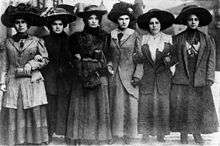Ida Rauh
| Ida Rauh | |
|---|---|
| Born |
March 7, 1877 New York City |
| Died |
February 28, 1970 (aged 92) New York City |
| Occupation | Feminist, actress, sculptor, poet |
| Spouse(s) | Max Eastman (1883–1969)[1] |
| Children | Daniel Eastman (1913–1969)[1] |
| Parent(s) | Samuel and Rosa Rauh |

Ida Rauh (March 7, 1877 – February 28, 1970) was a lawyer, suffragist, actress, sculptor, and poet who helped found the Provincetown Players in 1915. The players, including Susan Glaspell, George Cram Cook, John Reed, Hutchins Hapgood, Eugene O'Neill, and others, first performed in a structure owned by Mary Heaton Vorse in Provincetown, Massachusetts. Later, the group moved to a theater on MacDougal Street in Greenwich Village. In Provincetown, Rauh directed the first production of O'Neill's one-act play "Where the Cross Is Made", and in the Village she became known for her intensely emotional acting.[2]
Rauh graduated from the New York University law school in 1902, "with little hope of practicing law, so closed was the profession to her sex."[3] She became involved with the Women's Trade Union League, including efforts to assist in the shirtwaist-makers strike in New York in 1909.[3] Soon after, she traveled to England to join other militant women in the fight for women's suffrage.[3] Returning to New York, she helped Mabel Dodge organize her Village salon and became active in the feminist group Heterodoxy, formed in 1912.[4]
After her marriage to writer and editor Max Eastman in New York in 1911, Rauh made a point of keeping her maiden name.[2] In some places, such as Eastman's home town of Elmira, this was considered scandalous, the "first step on a slippery slope that led to feckless wives of loose morals, easy divorce, and free love".[3] Eastman, who edited the left-wing journals The Masses and The Liberator with the help of his older sister Crystal in the second decade of the 20th century, credited Rauh with introducing him to socialism.[1]
During her years in Greenwich Village, Rauh supported a variety of feminist causes, among them Margaret Sanger's campaigns. Arrested in 1916 for distributing birth-control information, Rauh was charged with obscenity and given a suspended sentence.[2]
Rauh left the theater in 1920 to pursue sculpture, painting, and other interests.[2] Among her works is a bust of writer D. H. Lawrence, who was one of her friends.[2] A book of her poems, And This Little Life, was published in 1959.[2] Her collected papers, including poems, television scripts, stage plays, correspondence, and other materials are housed in the American Heritage Center of the University of Wyoming in Laramie.[5]
Family
Rauh was the daughter of Samuel and Rosa Rauh of New York. Her marriage to Eastman ended in divorce in 1922, long after the two had separated.[2] The couple had one child, Dan,[2] with whom Eastman had no connection for 23 years after the separation.[3] By 1922, Rauh had moved to Santa Fe, New Mexico, with Dan and was living with painter Andrew Dasburg and his son, Alfred.[6] Rauh, Dasburg, and the two boys lived together until 1927–28 in New Mexico and in Woodstock, New York.[6] Dan, who became a psychologist, died of a heart attack in 1969 while talking to his mother on the telephone.[6] Rauh died a few months later.[6]
Work
- And Our Little Life. New York: Bookman Associates. 1959. OCLC 3397734.
- Papers, 1905–1960. OCLC 29737760.
References
- 1 2 3 "Max Eastman Dies: Author and Radical". The New York Times (obituary). March 26, 1969. p. 1.
- 1 2 3 4 5 6 7 8 "Ida Rauh Helped Create Theater". The New York Times (obituary). March 12, 1970. p. 41.
- 1 2 3 4 5 Stansell, Christine (2000). American Moderns: Bohemian New York and the Creation of a New Century. New York: Metropolitan Books: Henry Holt and Company. pp. 244–45; 264–65. ISBN 0-8050-4847-2.
- ↑ Golin, Steve (1988). Fragile Bridge: Paterson Silk Strike 1913. Philadelphia, Pennsylvania: Temple University Press. pp. 121–23. ISBN 0-87722-534-6.
- ↑ Rauh, Ida. "Papers, 1905–1960". WorldCat. OCLC 29737760. Retrieved February 22, 2014.
- 1 2 3 4 Gardner, Virginia (1982). Friend and Lover: The Life of Louise Bryant. New York: Horizon Press. pp. 237, 352. ISBN 0-8180-0233-6.